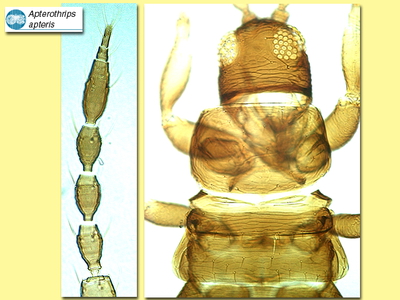Figures
Fig. 1 Antenna, head and thorax
Fig. 2 Sternite IV-VII
Fig. 3 Tergite VII-X (female)
Species
Apterothrips apteris Daniel
Biology
Reports on the biology of this wingless species are confusing. In California it has been shown to have localised populations confined to very small patches of Erigeron (Asteraceae), but in Western Australia and New Zealand it is known as a pest of lucerne. Moreover, Margaret Williams (Quarantine Entomologist, Tasmania) found it damaging garlic plants near Hobart, although at that same locality the species was common on grasses. Presumably, local populations develop a level of specificity to particular plants.
Distribution
Widespread in the southern hemisphere, including California, southern South America, the Falkland Islands, New Zealand, southern Australia, and Heard Island.
Recognition
Small, dark brown, apterous, species. Antennae 8-segmented, segment VI with a partial suture on ventral surface; segments III and IV with simple sense cone. Head with no ocelli. Pronotum with no long setae. Tergites and sternites bear distinctive posteromarginal craspedum, on each sternite the craspedum comprises five large lobes with the marginal setae arising between each lobe.
Related species
This species has frequently been misidentified asA. secticornis, the only other member of the genus. However, that species has the sternal craspedum divided into seven lobes, and appears to be restricted to the northern hemisphere, including Japan.




